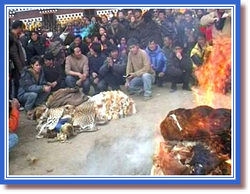Media Reports
The Tibetan Non-violence Movement
is A Shining Torch of Compassion
Reports according to Master's order and
rating
By Sister-initiate Jolly Chiou, San Jose, California, USA
(Originally in English) )
Having to survive in the adverse Himalayan environment for centuries, Tibetans have traditionally consumed wild animals both for food and clothing, resulting in ecological destruction and the endangerment of many rare species such as the white pheasant and blue sheep, which can only be found in this region.
Thus, as early as 1642, the Fifth Dalai Lama issued a Decree for the Protection of Animals and the Environment. Since then, such decrees have been issued annually, resulting in non-killing over longer periods and for larger numbers of animal species each year. In addition, the government has encouraged Tibetans to cultivate their land to produce alternative sources of food.
1989 Nobel Peace Prize recipient the14th Dalai Lama (♥♥♥♥♥♥)has been very active in such non-violence campaigns, and in his book The Human Approach to World Peace he states, “All beings seek peace, comfort and security. All living creatures, even a tiny insect strives to live as we humans do.”1 Moreover, since the Dalai Lama began encouraging the vegetarian diet among his followers in 1993, tofu consumption has gained in popularity as more Tibetans become vegetarians.2
And to further deter Tibetan communities in the Himalayas from using animal skins, the Dalai Lama has joined the animal welfare and conservation charity Care for the Wild International and the non-profit conservation group the Wildlife Trust of India. Regarding Tibetans’ use of animal products for clothing, he says, “I am ashamed and don’t feel like living when I see all those pictures of people decorating themselves with skins and furs. Never use, sell or buy wild animals, their products or derivatives.” 3
 Thus,
according to a Feb 18, 2006, CBS news report, “Thousands of Tibetans
have burned rare animal pelts and skins in response to a call by the Dalai
Lama, their exiled spiritual leader, to give up products made from endangered
animals.” 4
Thus,
according to a Feb 18, 2006, CBS news report, “Thousands of Tibetans
have burned rare animal pelts and skins in response to a call by the Dalai
Lama, their exiled spiritual leader, to give up products made from endangered
animals.” 4
Having special significance for neighboring
countries such as India, China, Bangladesh and Pakistan, the Tibetan non-violence
movement is also a guide and example for other governments as well, demonstrating
that respecting and preserving the environment and our cohabitants on
Earth is the key to sustaining both inner and outer peace. ![]()